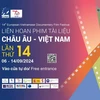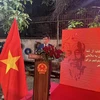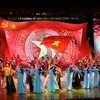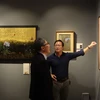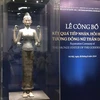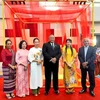 The reenactment of the traditional wedding of the Pa Then ethnic minority group on November 22 is one of activities in celebration of the 90th traditional day of the Vietnam Fatherland Front (November 18, 1930 - 2020), the 75th Vietnam Heritage Culture Day (November 23, 1945 - 2020), and the success of Party congresses at all levels towards the 13th National Party Congress. The event was jointly organized by the Vietnam National Village for Ethnic Culture and Tourism on the outskirts of Hanoi capital city and the Department of Culture, Sports and Tourism of the northern mountainous province of Ha Giang. (Photo: VietnamPlus)
The reenactment of the traditional wedding of the Pa Then ethnic minority group on November 22 is one of activities in celebration of the 90th traditional day of the Vietnam Fatherland Front (November 18, 1930 - 2020), the 75th Vietnam Heritage Culture Day (November 23, 1945 - 2020), and the success of Party congresses at all levels towards the 13th National Party Congress. The event was jointly organized by the Vietnam National Village for Ethnic Culture and Tourism on the outskirts of Hanoi capital city and the Department of Culture, Sports and Tourism of the northern mountainous province of Ha Giang. (Photo: VietnamPlus)  Being one of the 10 ethnic minority groups with the fewest populations, Pa Then people live in hamlets scattered in the northern mountainous provinces of Ha Giang and Tuyen Quang. According to Pa Then people’s custom, the groom can live with the wife’s family or the bride will move to her husband's house like the Kinh people. This depends on the conditions and agreements between families. The husband will stay with his wife’s family if the in-law family has few members, has no sons or is wealthier. The organizing board chooses to reenact the wedding of Pa Then people in My Bac hamlet, Tan Bac commune, Quang Binh district, Ha Giang province, during which the groom come to bring the bride to his house (Photo: VietnamPlus)
Being one of the 10 ethnic minority groups with the fewest populations, Pa Then people live in hamlets scattered in the northern mountainous provinces of Ha Giang and Tuyen Quang. According to Pa Then people’s custom, the groom can live with the wife’s family or the bride will move to her husband's house like the Kinh people. This depends on the conditions and agreements between families. The husband will stay with his wife’s family if the in-law family has few members, has no sons or is wealthier. The organizing board chooses to reenact the wedding of Pa Then people in My Bac hamlet, Tan Bac commune, Quang Binh district, Ha Giang province, during which the groom come to bring the bride to his house (Photo: VietnamPlus)  Before the wedding ceremony, the person who plays the role as the head of the hamlet of the groom’s side introduces to visitors the costumes of the groom and the bride on the wedding day. The two silver necklaces that the bride is wearing are presented by the bride’s family, symbolizing a desire for a long-lasting relationship between the couple. The two headscarves are for the couple to cover their faces when they come to eat at the paternal house (for the bride) and the maternal house (for the groom). According to the old custom, the headscarves covered their whole faces, but nowadays, the scarves only cover a part of faces, showing a positive change in Pa Then people’s way of thinking. (Photo: VietnamPlus)
Before the wedding ceremony, the person who plays the role as the head of the hamlet of the groom’s side introduces to visitors the costumes of the groom and the bride on the wedding day. The two silver necklaces that the bride is wearing are presented by the bride’s family, symbolizing a desire for a long-lasting relationship between the couple. The two headscarves are for the couple to cover their faces when they come to eat at the paternal house (for the bride) and the maternal house (for the groom). According to the old custom, the headscarves covered their whole faces, but nowadays, the scarves only cover a part of faces, showing a positive change in Pa Then people’s way of thinking. (Photo: VietnamPlus)  The wedding ceremony in the groom’s house. Before going to the bride’s house, the head of the groom’s family (right) gathered people to entrust tasks to the head (centre) and the deputy head (left) of the hamlet and other members of the delegation picking up the bride. After handing over the offerings to the head of the hamlet, the house owner offers a cup of wine to each person in the delegation and entrusts them with the task of picking up the bride. The head of the hamlet receives the mission and promises to bring the bride to the groom’s house safely and on time. (Photo: VietnamPlus)
The wedding ceremony in the groom’s house. Before going to the bride’s house, the head of the groom’s family (right) gathered people to entrust tasks to the head (centre) and the deputy head (left) of the hamlet and other members of the delegation picking up the bride. After handing over the offerings to the head of the hamlet, the house owner offers a cup of wine to each person in the delegation and entrusts them with the task of picking up the bride. The head of the hamlet receives the mission and promises to bring the bride to the groom’s house safely and on time. (Photo: VietnamPlus)  The offerings include 36 silver coins put in a small red bag tied with yellow strings, wine (which is contained in bamboo pipes but bottles are also used nowadays), two roosters, pork, confectionary, fruits, and a chicken cage decorated colourfully. Pa Then is one of the 10 ethnic minority groups with the fewest populations in Vietnam, mainly living in Tuyen Quang and Ha Giang provinces. In Pa Then custom, the newly-weds can live with the wife’s family or the husband's family like the Kinh people. This depends on the conditions and agreements between families. The husband will stay with his wife’s family if the in-law family has few members, no sons or is wealthier. (Photo: VietnamPlus)
The offerings include 36 silver coins put in a small red bag tied with yellow strings, wine (which is contained in bamboo pipes but bottles are also used nowadays), two roosters, pork, confectionary, fruits, and a chicken cage decorated colourfully. Pa Then is one of the 10 ethnic minority groups with the fewest populations in Vietnam, mainly living in Tuyen Quang and Ha Giang provinces. In Pa Then custom, the newly-weds can live with the wife’s family or the husband's family like the Kinh people. This depends on the conditions and agreements between families. The husband will stay with his wife’s family if the in-law family has few members, no sons or is wealthier. (Photo: VietnamPlus)  The head of the hamlet, carrying the chicken cage, leads the delegation to the bride’s house. The delegation should comprise of both men and women. In Chinese, 'Pa' means that 'family', whereas 'Then' means that 'eight', a reference to the present minority group's belief that they're originated from 8 founding families. Until now, the Pa Then ethnic minority group retains their distinctive customs, as well as their unique wedding tradition. For the Pa Then people, getting engaged is a difficult process, involving no less than six visits by the groom’s family to the bride's family. The groom can choose to live with the bride’s family or bring the bride to his home. (Photo: VietnamPlus)
The head of the hamlet, carrying the chicken cage, leads the delegation to the bride’s house. The delegation should comprise of both men and women. In Chinese, 'Pa' means that 'family', whereas 'Then' means that 'eight', a reference to the present minority group's belief that they're originated from 8 founding families. Until now, the Pa Then ethnic minority group retains their distinctive customs, as well as their unique wedding tradition. For the Pa Then people, getting engaged is a difficult process, involving no less than six visits by the groom’s family to the bride's family. The groom can choose to live with the bride’s family or bring the bride to his home. (Photo: VietnamPlus)  While on the road to the bride’s house, the groom is covered by a black umbrella to avoid evil and all bad luck, said the person playing the role as the head of the hamlet. On the way to the bride’s home, they are not supposed to drop into any places. Until now, the Pa Then ethnic minority group retains their distinctive customs, as well as their unique wedding tradition. For the Pa Then people, getting engaged is a difficult process, involving no less than six visits by the groom’s family to the bride's family. The groom can choose to live with the bride’s family or bring the bride to his home. (Photo: VietnamPlus)
While on the road to the bride’s house, the groom is covered by a black umbrella to avoid evil and all bad luck, said the person playing the role as the head of the hamlet. On the way to the bride’s home, they are not supposed to drop into any places. Until now, the Pa Then ethnic minority group retains their distinctive customs, as well as their unique wedding tradition. For the Pa Then people, getting engaged is a difficult process, involving no less than six visits by the groom’s family to the bride's family. The groom can choose to live with the bride’s family or bring the bride to his home. (Photo: VietnamPlus)  When the groom’s delegation arrives, the bride’s family does not open the door immediately. The head of the hamlet talks in a singing-like way to persuade the bride’s family to open the door. The Pa Then has the matrilocality custom under which a son-in-law can stay with his parents-in-law either temporarily or permanently. A groom can stay permanently with his parents-in-law if they do not have a son. In this case, the bride’s parents must send a person to the groom’s family to ask for their permission of such stay. If so agreed by the groom’s family, the bride’s family sends their representatives to the groom’s to discuss about the wedding and must hold the wedding for the couple. (Photo: VietnamPlus)
When the groom’s delegation arrives, the bride’s family does not open the door immediately. The head of the hamlet talks in a singing-like way to persuade the bride’s family to open the door. The Pa Then has the matrilocality custom under which a son-in-law can stay with his parents-in-law either temporarily or permanently. A groom can stay permanently with his parents-in-law if they do not have a son. In this case, the bride’s parents must send a person to the groom’s family to ask for their permission of such stay. If so agreed by the groom’s family, the bride’s family sends their representatives to the groom’s to discuss about the wedding and must hold the wedding for the couple. (Photo: VietnamPlus)  A representative of the bride’s family (first, left) receives the head and deputy head of the groom’s hamlet. After drinking wine, the groom’s family presents the offerings to the bride’s family. The offerings include 36 silver coins put in a small red bag tied with yellow strings, wine contained in bamboo pipes (bottles are also used nowadays), two roosters, pork, confectionary, fruits, and a chicken cage decorated colourfully. When the two families are talking, the groom and bride put a tray of offerings to the ancestor altar in a rite to see off the spirit of the bride to her husband’s home. The groom removes a covering kerchief for the bride’s ancestors to see his face. (Photo: VietnamPlus)
A representative of the bride’s family (first, left) receives the head and deputy head of the groom’s hamlet. After drinking wine, the groom’s family presents the offerings to the bride’s family. The offerings include 36 silver coins put in a small red bag tied with yellow strings, wine contained in bamboo pipes (bottles are also used nowadays), two roosters, pork, confectionary, fruits, and a chicken cage decorated colourfully. When the two families are talking, the groom and bride put a tray of offerings to the ancestor altar in a rite to see off the spirit of the bride to her husband’s home. The groom removes a covering kerchief for the bride’s ancestors to see his face. (Photo: VietnamPlus)  According to the head of the hamlet, the bride’s costumes are the traditional costumes of Pa Then women during important festivals. However, there are three scarves which make the bride look different on her wedding day, one on her head to cover her face when she arrives at the groom’s house, another wrapped around her neck to be given to her parents-in-law to clean their hands when she enters her husband’s home, and the third is a red scarf only used for brides on their wedding day. In Pa Then custom, the newly-weds can live with the wife’s family or the husband's family like the Kinh people. This depends on the conditions and agreements between families. (Photo: VietnamPlus)
According to the head of the hamlet, the bride’s costumes are the traditional costumes of Pa Then women during important festivals. However, there are three scarves which make the bride look different on her wedding day, one on her head to cover her face when she arrives at the groom’s house, another wrapped around her neck to be given to her parents-in-law to clean their hands when she enters her husband’s home, and the third is a red scarf only used for brides on their wedding day. In Pa Then custom, the newly-weds can live with the wife’s family or the husband's family like the Kinh people. This depends on the conditions and agreements between families. (Photo: VietnamPlus)  The groom's family continues to prepare a tray of offerings in front of the house, including a pig head, a set of pig innards, 10 cups and two bottles of wine. The delegations of the groom’s and bride’s families stand besides the tray to announce the success of their mission. Being one of the 10 ethnic minority groups with the fewest populations, Pa Then people live in hamlets scattered in the northern mountainous provinces of Ha Giang and Tuyen Quang. The Pa Then has the matrilocality custom under which a son-in-law can stay with his parents-in-law either temporarily or permanently. A groom can stay permanently with his parents-in-law if they do not have a son. (Photo: VietnamPlus)
The groom's family continues to prepare a tray of offerings in front of the house, including a pig head, a set of pig innards, 10 cups and two bottles of wine. The delegations of the groom’s and bride’s families stand besides the tray to announce the success of their mission. Being one of the 10 ethnic minority groups with the fewest populations, Pa Then people live in hamlets scattered in the northern mountainous provinces of Ha Giang and Tuyen Quang. The Pa Then has the matrilocality custom under which a son-in-law can stay with his parents-in-law either temporarily or permanently. A groom can stay permanently with his parents-in-law if they do not have a son. (Photo: VietnamPlus)  Finally, representatives from the groom’s and bride’s sides use the two scarves wrapped on the groom’s and bride’s necks to clean their hands. In each basin there is a red envelope with two silver coins inside. This is considered the bride and groom's thanks to the hamlet mandarins for helping the wedding ceremony complete and succeed. The Pa Then has the matrilocality custom under which a son-in-law can stay with his parents-in-law either temporarily or permanently. The groom will be responsible for affairs of his wife’s family and take care of her parents. If staying temporarily, a Pa Then groom can stay with his wife’s family for up to 12 years. The purpose of this stay is for the groom to repay his parents-in-law for raising his wife. (Photo: VietnamPlus)
Finally, representatives from the groom’s and bride’s sides use the two scarves wrapped on the groom’s and bride’s necks to clean their hands. In each basin there is a red envelope with two silver coins inside. This is considered the bride and groom's thanks to the hamlet mandarins for helping the wedding ceremony complete and succeed. The Pa Then has the matrilocality custom under which a son-in-law can stay with his parents-in-law either temporarily or permanently. The groom will be responsible for affairs of his wife’s family and take care of her parents. If staying temporarily, a Pa Then groom can stay with his wife’s family for up to 12 years. The purpose of this stay is for the groom to repay his parents-in-law for raising his wife. (Photo: VietnamPlus) VNA




